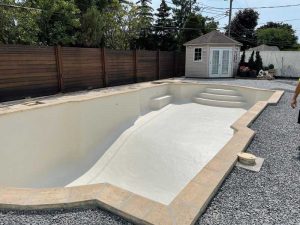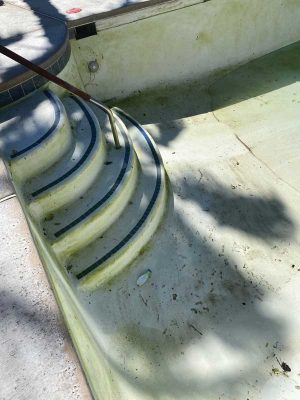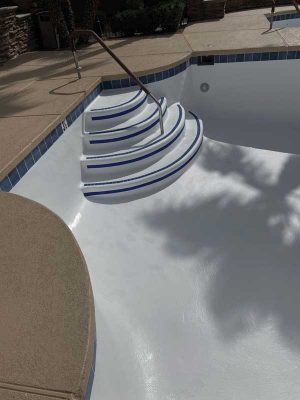Pool resurfacing
by brittney_cutler_2 | September 3, 2021 10:56 am
 [1]
[1]The use of micro-glass-reinforced coatings is a novel way to refinish pools and spas. These coatings are unlike conventional pool paints currently used in the pool industry, as durability and performance of traditional polymers remain an ongoing issue where long-term performance is desired.
Glass flake coatings address these shortcomings. They are also an excellent alternative to cementitious materials, especially in the waterpark and commercial pool arena where operational costs are a concern. Micro-glass coatings are a workhorse product for large bodies of water as they can be applied fast with minimal labour.
Although other forms of composite coatings have been used before, this method is different because glass is added into the resin, thus allowing the resin and glass compound to be sprayed as one homogenous material, thereby eliminating fibreglass mat.
Disbondment was a common problem with mat-type methods. With the glass addition into the resin, this has had a positive influence on bond promotion, and prevents undercutting of the coating because of the elimination of tensile stresses built up in mat-type applications. High shrinkage of thermoset resins is one of the primary causes of disbondment from concrete substrates. During the polymer polymerization (i.e. cross-linking process, there is a volumetric change in the coating. This change can cause the coating to lose bond. (As an aside, thermoset resins have an eight per cent shrinkage coefficient.) These shrinkage stresses can cause the resin to heave off the concrete.
Glass flake coatings
Glass flake coatings were developed in the United States in the early ’60s. They were first used for heavy-duty industrial protective coatings for steel and concrete corrosion protection. As all organic coatings will, to some extent, convey moisture vapour and allow gas diffusion, preventing or resisting this is key. It is here glass flakes initially found their niche before being used in the pool industry. With decades of service in immersion conditions, some 20-year-old sea water applications have been inspected and put back into service.
Glass flakes are platelets or flakes of varying particle size and thickness. They overlap each other and extend the path distance in a coating film, providing a barrier to the passage of moisture and gas diffusion by creating a tortuous path through it. There are different glass types, but in the corrosion coatings sector, electronic corrosion resistant (ECR) glass offers the highest levels of chemical resistance and is inert for corrosive chemical environments.
Resin binder selection is just as important as the glass type, so the glass/resin compound delivers the best outcome. Several thermoset resin types are used depending on the cargo. Further, the level of glass flake also has a bearing on coating thickness and flexibility.
It is evident there are many benefits to using glass flake, particularly for coatings. This is not a new concept for pools; base resins have been used in California for 30 years and micro-glass coatings are being used across the United States and Canada.
 [2]
[2]What are micro-glass coatings?
It is a more complex material than standard paints used in the pool industry. These coatings are a high-performance, high-build, corrosion-resistant, glass fibre-reinforced polymer spray-applied to steel and concrete. Plural component spray equipment is used. The hose length is 61 m (200 ft) and eliminates hot potting. For efficiency, 208 L (55 gal) drums are used and remain on a trailer during spraying operations. The spraying of coatings can yield superior results to other coating applications. All complex polymer coatings are spray-applied.
Benefits of glass flake in coatings include:
• improved thermal stabilization and mechanical properties of the coating;
• reduced gas and moisture permeation;
• extended coating life and consequently a long service life;
• less cracking and peeling;
• increased hardness, wear, chemical and abrasion-resistance;
• low ife-cycle cost without periodic refinishing; and
• superior moisture vapour transmission (MVT).
 [3]
[3]Preparation
Preparation depends on the type of pool. Fibreglass pools require light abrasion, before spraying. The application rate is fast at 93 m2 (1000 sf) in under 60 minutes. That said, it is important for applicators to repair any suspect areas first.
Marbelite pools must be acid etched for bond promotion—chipping out of old plaster is not required; however, masking off the deck and fittings is important. Steel pools must be abrasive blasted for an angular 0.13 mm (5 mil) profile, then primed to avoid flash rust.
These coatings can be applied to properly finished gunite and formed concrete pools. The finish is tile-like at a much lower cost. Also, it can be used to finish vinyl pools where polymer panels are used. Glass flake coatings can be easier to use than vinyl with no sizing, fitting, or cutting required, which means the installation can be performed faster. The service life in vinyl pools is exceptional, and the product conforms to any shape and size.
The use of insulated concrete forms (ICF) is gaining in popularity as it is less expensive than gunite and conventional concrete forming systems. Micro-glass coatings can also be used on these pool installation systems. In fact, builders/installers can save a significant amount of time and material on large projects like waterparks when using a micro-glass/ICF combination.
Dosing the drums with glass flake
The glass flake is added to the resin in a staggered fashion for complete integration and dispersion. A special type of mixer is used. In general, mixing coatings is more scientific than one may think. The mixer must have the correct mixing blade for proper dispersion of the glass fibre, and the mixer must have enough torque to move the material around in the drum. Failure to mix the coating properly can cause the compound to clog the gun and result in other quality issues.
 [4]
[4]Application
Once the pool is prepared and masked off, the high-performance primer is applied to marbelite pools. First, the walls are sprayed, then the floor, in a specific spraying pattern. Applicators must observe proper spraying techniques as this will determine the correct deposition of the material. If improper techniques are used, runs, sags, and other defects can appear. Proper techniques will also improve the cosmetics and esthetics of the coating. That said, applicators must be mindful of how they use the gun. Among other things, speed of moving the gun and distance from the substrate are a few examples of proper techniques. Maintaining good form (ergonomics) is always important.
In brief, the compound is applied 1.3 to 2 mm (50 to 80 mils) thick. The correct resin temperature must always be maintained as resin heaters are used in conditions under 15 C (60 F). The resin temperature determines cure levels and flowability off the resin through the gun.
Cure time
Cure time is determined by ambient and resin temperature, though cure times of under 10 hours can be achieved. Cure times can be accelerated by increasing the resin temperature and adding more catalyst. Higher ambient temperatures expedite the curing process. Cures are stunted by low catalyst levels, cold resin, and low ambient temperatures.

Startup
Pool startup is less costly and time-consuming compared to other finishes as polymers are inert and they do not react with water chemistry. There is no induction or brushing period required and less trips are made to the pool—just simply add the startup chemicals. Pool startup can be achieved faster and easier because there are not a lot of water parameter adjustments that need to be made to bring the water into balance. Further, pool chemicals are more efficient; therefore, less are used. With cementitious materials there is an interaction between the water and the surface.
Hot water spas
Hot water in concrete spas is aggressive on cement-based finishes. Typical issues include spalling, roughness, black algae, and loss of esthetics. Snagged bathing suits of swimmers is another common complaint. The glass coating compound delivers a tile-like finish so black algae cannot adhere. Commercial spas are heated to upward of 40.5 C (105 F). The compound performs well in these temperatures (and even higher) so repeated resurfacing is not required.
There are also several advantages for remodelling contractors. The product is sprayed and does not need to be worked with trowels or rollers. Preparation is minimal and can be applied to marginally prepared surfaces. With a low labour requirement, speedy application, and a temperature-dependent quick cure time, spas can be completed in 1.5 hours.
 [5]
[5]Micro-glass coating spa surfaces:
• will not get rough especially in the hot water environment of a spa;
• can be modified to address cracks and leaks;
• will not readily stain;
• are resistant to black algae;
• are unaffected by high salt concentrations;
• provide a forgiving surface; and
• are non-sensitive to out-of-balance pool and spa chemistry.
With all the pool resurfacing products available, micro-glass coatings are a strong contender for resurfacing pools and spas. When it comes to refinishing pools and spas, high-performance, glass-reinforced polymers offer one of the lowest life cycle costs and can be used to address a variety of pool and spa surface issues.
 Peter Gibson is the technical director for GRC Composite Coatings in Hayward, Calif. He has been involved in the composite coatings industry for more than 30 years. Gibson is a consultant and specifications writer for composite coatings and linings projects and an instructor for the certified applicator training course.
Peter Gibson is the technical director for GRC Composite Coatings in Hayward, Calif. He has been involved in the composite coatings industry for more than 30 years. Gibson is a consultant and specifications writer for composite coatings and linings projects and an instructor for the certified applicator training course.
He can be reached via email at resinmaster@gmail.com.
- [Image]: https://www.poolspamarketing.com/wp-content/uploads/2021/10/Completed_GlassCoat_pool_after_crack_restoration.jpg
- [Image]: https://www.poolspamarketing.com/wp-content/uploads/2021/10/Pool_before_crack_remediation_and_GlassCoat_application__Photo_courtesy_Aqua-Spray_Montreal_QC.jpg
- [Image]: https://www.poolspamarketing.com/wp-content/uploads/2021/10/Repairing_concrete_cracks_with_glass_and_carbon_fibre.jpg
- [Image]: https://www.poolspamarketing.com/wp-content/uploads/2021/10/Completed_GlassCoat_pool_after_crack_restoration.jpg
- [Image]: https://www.poolspamarketing.com/wp-content/uploads/2021/10/IMG_0711.jpg
Source URL: https://www.poolspamarketing.com/trade/features/pool-resurfacing/